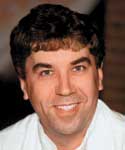Article
BPH: Data needed to sort out ideal office-based treatment
Paris--Minimally invasive and surgical treatments for BPH are poorly studied and lack standardized techniques, said Jean de la Rosette, MD, of the department of urology, University of Amsterdam. Dr. de la Rosette chaired a committee on these rapidly expanding treatment approaches at the International Consultation on New Developments in Prostate Cancer and Prostate Diseases. Therapies considered by the committee included transurethral microwave thermotherapy, transurethral needle ablation, transurethral resection of the prostate, water-induced thermotherapy, transurethral ethanol ablation of the prostate (TEAP), prosthetic stents, and lasers.

While TURP is the committee's most widely recommended technique, it has significant limitations.
"TURP is very poorly studied, there is no standard technique, and it is lacking durable, long-term data," said Dr. de la Rosette.
"The newer kids on the block, like bipolar resection, are being included without proper study," according to Dr. de la Rosette.
Most of the data on TURP are being generated from randomized studies comparing it to minimally invasive treatments, he said.
There is strong evidence supporting TUMT, with symptomatic improvement similar to that seen with TURP. In a study of over 200 patients, TUMT showed a re-treatment rate of 29% (BJU Int 2003; 92:713-8). TUMT offers a durable outcome, low morbidity, outpatient-based convenience, and is recommended by the committee when instrumental treatment is indicated, said Dr. de la Rosette. To put instrumental therapies in perspective, he cited Medline data from 1992-2002 of 174 studies with over 17,000 patients: At baseline and follow-up, all results of instrumental treatment were in the same range for symptoms and quality of life scores.
The committee also recommended TUNA, which delivers radiofrequency to the prostate and has outcomes similar to those of TUMT. In a study of 188 patients, symptomatic improvement occurred in about 50% and peak flow rate averaged 70% (Eur Urol 2003; 44:89-93).
TEAP, which uses alcohol injections to ablate prostate tissue, and prosthetic stents are considered investigational by the committee because data are limited. TEAP has shown substantial (>50%) improvement in peak flow rates at 1-year follow-up, but concerns about safety remain. Stents are a minimally invasive option for high-risk patients, but their clinical use is limited. Although long-term data suggest they are safe, the committee does not recommend their use until further evaluation has been carried out.
Lasers: More data needed
Similarly, use of the newer lasers considered by the committee lacks supporting data. Holmium laser enucleation of the prostate (HoLEP) has shown significant efficacy in several case series, with the same outcome as TURP at 1-year follow-up in a study comparing the two procedures (J Urol 2004; 172:616-9).
Some of the early data on photoselective vaporization of the prostate have been spectacular, Dr. de la Rosette said, showing significant improvement in peak flow rate and International Prostate Symptom Scores, but the results lack long-term follow-up. More data are also needed for the potassium-titanyl-phosphate (KTP) laser, he said.
The committee concluded that the efficacy of TURP is better than that of microwave technologies, but with higher morbidity resulting from prostate resection. Technical improvements, clinical outcomes, and morbidity need to be weighed against patient preferences in selecting a treatment, according to Dr. de la Rosette. In addition, a patient-friendly document would help men know what to expect from different treatments.
"We should produce something for patients. Every patient would like a speedy onset of improvement," he said. "Cost is also an issue. In the future, we should move away from how much techniques cost to how much is the patient willing to pay."
The committee also acknowledged wide variability in clinical outcomes with prostate resection, which it says is difficult to explain.
"Sometimes there is a mismatch with findings on ultrasound," Dr. de la Rosette concluded.





